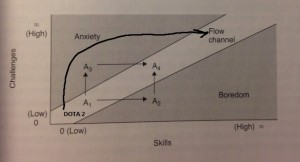I feel like we can incorporate what Schelle described in our book to DOTA 2. This game is very frustrating. There are 100+ heroes and 100+ items. You are going to have to learn all of them to be good at the game. It is going to take a lot of time. Furthermore, there are different levels of play. This is a team game, the professionals are going to coordinate and plan every part of the game much better than what we are going to accomplish by solo queuing for a game. This means that team compositions will provide various results and item/skill builds are going to be different. What I’m trying to say is something you saw in a pro game will not always work in a “pub” game. TI3 commentator and DOTA 2 player, Purge, even titles his guide “Welcome to Dota, You Suck.” http://www.purgegamers.com/welcome-to-dota-you-suck#.UzCQ-F5ED8U This will not make you a pro after one read but it will give you an idea of what to look out for. However, after dedicating a good bit of time to this game your skills will increase and you will finally start to enjoy it.
This is how I would interpret the challenge vs. skills graph for DOTA 2.


I don’t play DOTA 2 but talking about challenge VS skills, I think FIFA did a good job in this. FIFA makes the players strictly move in the flow tunnel. There is a game mode in FIFA called Season Online, where basically enables you to play with random people around the world with roughly the same skill level. You start from Division 10 and your goal is to try your best to go all the way up to Division and win the league title. Obviously it will be more and more challenging as you go to a higher division but your skills will be greatly improved as well as you spend more and more time on it. In this way, players will be much less likely to be extremely anxious or bored.
I fully agree with your representation of the learning curve. What about the game causes newer players so much anxiety? So, everyone in the game has to worry about their current positioning and what is going on in the game at that moment. For a new player, they are constantly out of their comfort zone. Am I too close to the enemy? Too far away? What item should I build next? Where do I buy that item? What skills to level first? A seasoned player is comfortable in the game and knows the answer to these questions, allowing them to focus on the specifics and capitalize on quirks of the game. Once you’ve mastered the basics of the game and feel comfortable, that is when you can really work on the more advanced aspects that improve your play.
What i believe DOTA2 and other games like it were going with being super hard, is simply be a game that you could never master. No matter how high your skill is there is always something competitive to do, a new skill to learn and a new champion to master. I think your representation is a tad off, but instead of even starting in the flow channel the game just simply starts outside of it and works into the flow. As your skill gets better, you fall closer into the flow zone where simply is where you would stay. As you progress in a solo queue style you get closer and closer to people of similar skill and closer and closer to the flow of the game.
Once you hit the flow zone, you only fall out of it when you do not play the game a lot or for some reason you start facing people way out of your league. This would move your line to losing skill based on others. So for a game like DOTA2 Schell’s graph does work, but i feel that because it is a team game, Average Skill and Average Challenge, should be the X and Y portions respectively. The collective average skill and challenge propels players into their flow zone and overall have fun with the game. Yes everything is overwhelming at the start, but once you get moving i feel you would never stop getting closer and staying in this zone, assuming you never stop yourself.
In all, DOTA2 and other MOBA style games typically have this style of graph where it just isn’t your skill but an average of all the skills of your teammates. Valve and other companies tweak the game so one side is never overpowered, thus supporting this model. This was also assuming DOTA2 has a match making system similar to LoL with where you get matched with people of similar skill. Otherwise i am at a loss where they are going with this subject.
TL;DR DOTA2 and Other MOBAs has an Average Skill/ Average Challenge rather than a personal Skill/Challenge graph to represent flow in the game.